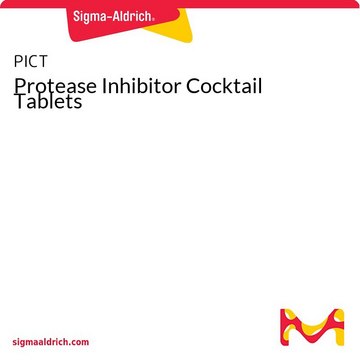P2714
Protease Inhibitor Cocktail
lyophilized powder, for the inhibition of serine, cysteine and metallo-proteases, for general use, lyophilized powder
Synonym(s):
Protease Inhibitor Cocktail from bovine lung, Protease Inhibitor Mix, Protease inhibitor
Sign Into View Organizational & Contract Pricing
All Photos(1)
About This Item
UNSPSC Code:
12352200
NACRES:
NA.77
form:
lyophilized powder
solubility:
water: soluble
storage temp.:
−20°C
Recommended Products
Product Name
Protease Inhibitor Cocktail powder, for general use, lyophilized powder
biological source
bovine lung
Quality Level
form
lyophilized powder
solubility
water: soluble
storage temp.
−20°C
Looking for similar products? Visit Product Comparison Guide
General description
The protease inhibitor cocktail has been optimized and tested for general use. It consists of water-soluble protease inhibitors that effectively inhibit serine, cysteine, and metalloproteases. This product is supplied as a lyophilized powder.
Specificity
Inhibits serine, cysteine, and metallo-proteases.
Application
Protease Inhibitor Cocktail powder has been used as a component:
- in radioimmunoprecipitation assay buffer to lyse the avian crystalline lens samples for western blot analysis
- in phosphate buffer solution (PBS) for grinding recombinant protein expressed leaves to purify virus-like particles (VLPs)
- in PBS to dissolve lyophilized skin secretion sample of A. loloensis for peptide purification
- in 0.1 M NaCl solution to wash and collect skin secretions of frog
Biochem/physiol Actions
The components of this mixture, such as AEBSF and Aprotinin act to inhibit serine proteases, including trypsin, chymotrypsin, and plasmin amongst others. Bestatin inhibits aminpeptidases. E-64 acts against cystein proteases. EDTA is an inhibitor of metalloproteases. Leupeptin acts against both serine and cystein proteases.
Components
This mixture contains individual components, including:
AEBSF at 2 mM
Aprotinin at 0.3 μM
Bestatin at 116 μ
E-64 at 14 μM
EDTA at 1 mM
Leupeptin at 1 μM
Each component has specific inhibitory properties.
AEBSF at 2 mM
Aprotinin at 0.3 μM
Bestatin at 116 μ
E-64 at 14 μM
EDTA at 1 mM
Leupeptin at 1 μM
Each component has specific inhibitory properties.
Caution
The lyophilized powder is stable for 4 years when stored at -20°C.
Quantity
One bottle makes 100 mL of cocktail, which are sufficient to the inhibition of proteases present in approximately 20 gram of cell extract.
Not all extracts contain the same levels of endogenous enzymes, and it may be necessary to adjust the volume of cocktail required.
Not all extracts contain the same levels of endogenous enzymes, and it may be necessary to adjust the volume of cocktail required.
Preparation Note
This product is supplied as a lyophilized powder. One bottle prepares 100 mL of a cocktail solution.
Other Notes
For R&D use only. Not for drug, household, or other uses. Please consult the Safety Data Sheet for information regarding hazards and safe handling practices.
related product
Product No.
Description
Pricing
Signal Word
Warning
Hazard Statements
Precautionary Statements
Hazard Classifications
Eye Irrit. 2 - Skin Irrit. 2
Storage Class Code
11 - Combustible Solids
WGK
WGK 3
Flash Point(F)
Not applicable
Flash Point(C)
Not applicable
Choose from one of the most recent versions:
Already Own This Product?
Find documentation for the products that you have recently purchased in the Document Library.
Customers Also Viewed
Giorgio Ramadori et al.
Nature communications, 10(1), 3545-3545 (2019-08-09)
Tens of millions suffer from insulin deficiency (ID); a defect leading to severe metabolic imbalance and death. The only means for management of ID is insulin therapy; yet, this approach is sub-optimal and causes life-threatening hypoglycemia. Hence, ID represents a
F Maier et al.
Osteoarthritis and cartilage, 27(9), 1382-1391 (2019-05-24)
Given the structural changes associated with the progression of Osteoarthritis (OA), we hypothesized that patterns of through-thickness, large-strain shear evolve with early-stage OA. We therefore aimed to determine whether and how patterns of shear strains change during early-stage OA to
Effects of phosphodiesterase 4 inhibition on alveolarization and hyperoxia toxicity in newborn rats.
Céline Méhats et al.
PloS one, 3(10), e3445-e3445 (2008-10-23)
Prolonged neonatal exposure to hyperoxia is associated with high mortality, leukocyte influx in airspaces, and impaired alveolarization. Inhibitors of type 4 phosphodiesterases are potent anti-inflammatory drugs now proposed for lung disorders. The current study was undertaken to determine the effects
Hongying Tan et al.
Journal of neuroinflammation, 11, 93-93 (2014-06-03)
Patients with postoperative cognitive dysfunction have poor outcomes. Neuroinflammation may be the underlying pathophysiology for this dysfunction. We determined whether proinflammatory cytokines affect the trafficking of α-amino-3-hydroxy-5-methyl-4-isoxazolepropionic acid receptors to the plasma membrane, a fundamental biochemical process for learning and
C Zhang et al.
Cell death & disease, 5, e1138-e1138 (2014-03-22)
By screening a collection of one hundred combinations of thiazolidinone compounds, we identified one combination (M4) that synergistically inhibited the growth of H460 and H460/TaxR cells and tumor growth in H460/TaxR xenograft mice. A whole genome microarray assay showed that
Our team of scientists has experience in all areas of research including Life Science, Material Science, Chemical Synthesis, Chromatography, Analytical and many others.
Contact Technical Service














